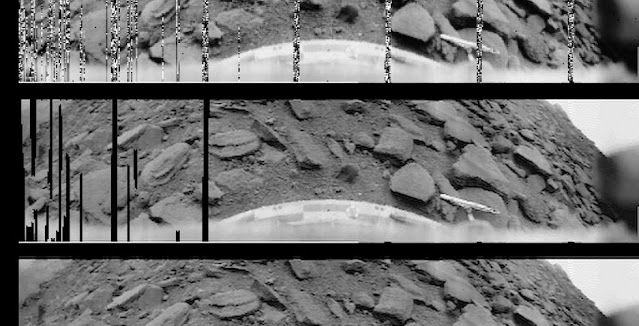ROSCOSMOS - Venera-9 Mission patch.
Oct. 22, 2020
The automatic interplanetary station "Venera-9" was launched on June 8, 1975. It consisted of an orbiter, a corrective-braking propulsion system and a descent vehicle with a heat-shielding shell. The purpose of the Soviet interplanetary station Venera-9 was to deliver the descent vehicle to the surface of Venus, conduct scientific research along the flight path, on the surface of the planet and from the orbit of an artificial satellite of Venus.
The automated spacecraft Venera-9 became the world's first artificial satellite of Venus. The Venera-9 lander on October 22, 1975 made a soft landing on the illuminated side of the planet in the northern hemisphere and transmitted information from the surface for 53 minutes. The world's first panorama of the surface of Venus was obtained.
From a TASS message: “... On October 22, 1975, the Venera-9 interplanetary station, having covered a distance of more than 300 million kilometers in 136 days of flight, was launched into orbit around Venus and became the first artificial satellite of Venus in history. The lander of the station made a soft landing on the surface of Venus. For the first time in the atmosphere of the planet Venus at a pressure 90 times greater than on Earth and a temperature of 485 degrees Celsius, a unique image of the surface of Venus at the landing site was obtained ... ".
Flight results
For the first time, panoramic television images from another planet were transmitted. In the panoramas made up of television images transmitted from the Venera-9 descent vehicle, outcrops of bedrock are visible, the breakdown of stones may be the result of displacements in the crust and serve as confirmation of tectonic activity on Venus.
Venera-9
The descent vehicle measured the density, pressure, temperature of the atmosphere, the amount of water vapor, nephelometric measurements of cloud particles, measurements of illumination in different parts of the spectrum. In addition to a gamma spectrometer, a radiation density meter was used to measure soil characteristics.
Artist's concept of Venera 9 landed on Venus. Image Credit: ESA
Venera 9 measured the illumination near the surface - these measurements showed that 5-10% of the solar energy reaches the planet's surface in the form of radiation scattered by clouds. Artificial satellites made it possible to obtain television images of the cloud layer, the temperature distribution over the upper boundary of the clouds, the spectra of the planet's night glow, to carry out studies of the hydrogen corona, repeated radio illumination of the atmosphere and ionosphere, and the measurement of magnetic fields and near-planetary plasma. The detection of thunderstorms and lightning in the cloud layer on the planet has attracted much attention. The data of optical measurements showed that the energy characteristics of Venusian lightning are 25 times higher than the parameters of earth lightning.
ROSCOSMOS Press Release: https://www.roscosmos.ru/29448/
Images, Text, Credits: ROSCOSMOS/Orbiter.ch Aerospace/Roland Berga.
Greetings, Orbiter.ch







